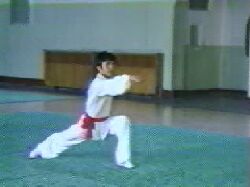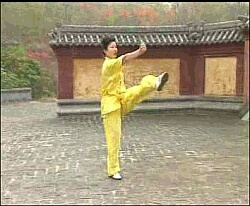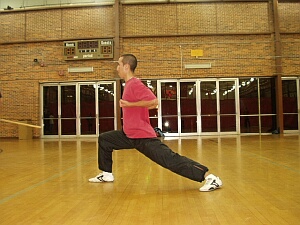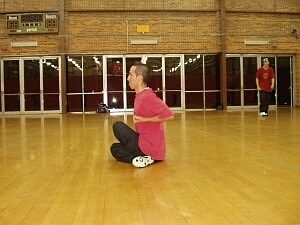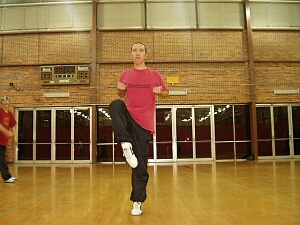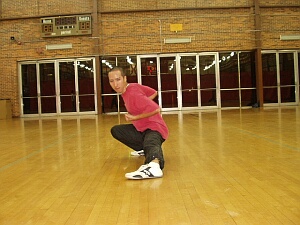
Wushu Reference
| This section is provided as a reference for members of FSU Wushu. It is not intended to be a primary instructional tool. |
Contemporary Wu Bu Quan
Contemporary Chang Quan
Contemporary Nan Quan
Video of contemporary Nan Quan form available for download:This is a video of a beginner/intermediate level contemporary Nan Quan form. |
Chang Quan 1 Punch Set
|
These are the CQ-1 punches: (Chambers for hands should be high. Eyes should follow punch. The first 7 punches to be done with feet at shoulder width, legs straight.) 1) Thrusting Fist Key Points: Fist should be a flat/horizontal fist. Extend arm, turn shoulder and waist to extend reach of fist, but keep hips square. 2) Pushing Palm Grab Key Points: Palm hand should have fingers together and thumb in. Grab by curling fingers down, while still together, into a fist. Extend arm, turn shoulder and waist, but keep hips square. 3) Chopping Fist Key Points: Fist should be straight/vertical. Raise fist raise straight up. When chopping down, turn shoulder and waist to extend reach of fist, but keep hips square. 4) Drilling Fist Key Points: Fist should drop straight back, turn up in a arm curl motion to near ear with thumb side down. Drill fist forward and down with thumb side towards knees. Slight bend in elbows and turn shoulder and waist, but keep hips square. 5) Horizontal Thrust Swing-Up Key Points: Hand should be palm up thrusting to the side at shoulder height. Turn wrist to palm out to side then while maintaining an extended arm, raise straight up above head. Head should turn to the opposite side when raising arm. 6) Horizontal Guard Swing-Over Key Points: Extended arm's hand should be palm up to the side at shoulder height. Guarding arm's hand in front of body should be palm down guarding underarm of extended arm. Both arms should reach to be extended when raising arms above head and setting down on on opposite side. 7) Horizontal Palm Chop Key Points: When chopping across the body, palm should be up with shoulder and waist turned to reach. When chopping on the side, palm should be down at shoulder height. Head to turn and eyes follow direction of movement. 8) Push Elbow Open Palm Key Points: To be done in transitioning bow step from side to side. Pushing elbow's hand should be in horizontal fist. Supporting hand's palm to brace. Open palms outward and push to sides while turning head to opposite side. Transition to opposite side in bow step and push elbow again. |
Stances
Pronounced: Ma Bu Key Points: Top of thighs should not drop below 90 degrees. Knees should point outwards. Feet pointed forward.
Pronounced: Gong Bu Key Points: Forward knee should not pass food. Width should be shoulder width. Back leg should be straight. Back foot at 45 degree angle.
Pronounced: Chu Bu Key Points: Weight about 99% on back leg. Back foot at 45 degree angle. Forward leg slightly bent. Forward foot's big toe touching ground. Forward foot not to cross center line.
Pronounced: Chi Bu Key Points: Thighs anchor each other in place. Width not to be wider than shoulder width. Back foot should be on ball of foot. Buttocks to be seated on back leg's calf/achilles.
Pronounced: Tros Pan Bu Key Points: Feet should be a little more than shoulder width when twisting into this stance. Feet should pivot but not shift when twisting into this stance. Buttocks may sit on floor or on bottom foot. Use top leg's foot to anchor on floor when twisting out of stance.
Pronounced: Ging Gai Du Lai Key Points: Raised leg's thigh should be flat or higher. Raised leg's foot sould be point down and be infront of supporting leg's knee/thigh.
Pronounced: Pu Bu Key Points: Crouch all the way down. Back of crouched leg's thigh should make contact with calf. Crouched leg's foot should be flat on floor. Extended leg's foot should be flat on floor. |
Stance Form
|
This is the order for the mobile stance form: (Start with feet together, hands in high chamber ready) 1) Ma Bu - right foot circle forward and out to right side 2) Gong Bu - right foot circle forward and to left, then out to front right corner 3) Gong Bu - left foot circle forward and to right, then out to front left corner 4) Ma Bu - right foot circle forward and to left, then out to right side 5) Gong Bu - right foot circle backward and to left, then out to back right corner 6) Gong Bu - left foot circle backward and to right, then out to back left corner 7) Ma Bu - right foot circle backward and to left, then out to right side 8) Chu Bu - right foot step forward 9) Ma Bu - right foot step backward to right side 10) Chu Bu - left foot step forward 11) Ma Bu - left foot step backward to left side 12) Chi Bu - right foot cross over left foot to left side 13) Ma Bu - right foot step back over to right side 14) Chi Bu - left foot cross over right foot to right side 15) Ma Bu - left foot step back over to left side 16) Tros Pan Bu - twist down to left 17) Ma Bu - twist up to right 18) Tros Pan Bu - twist down to right 19) Ma Bu - twist up to left 20) Ging Gai Du Lai - right leg raised 21) Pu Bu - right leg doward to right side extended 22) Ma Bu - right leg shift in 23) Ging Gai Du Lai - left leg raised 24) Pu Bu - left leg downward to left side extended 25) Ma Bu - left leg shift in (Jun Bey - end by hopping with both feet in to feet together, hands in front together) Key Points: Back should be straight and torsal should face forward. Try to minimize up and down motion of body when shifting between stances. |
